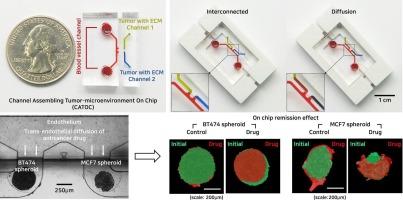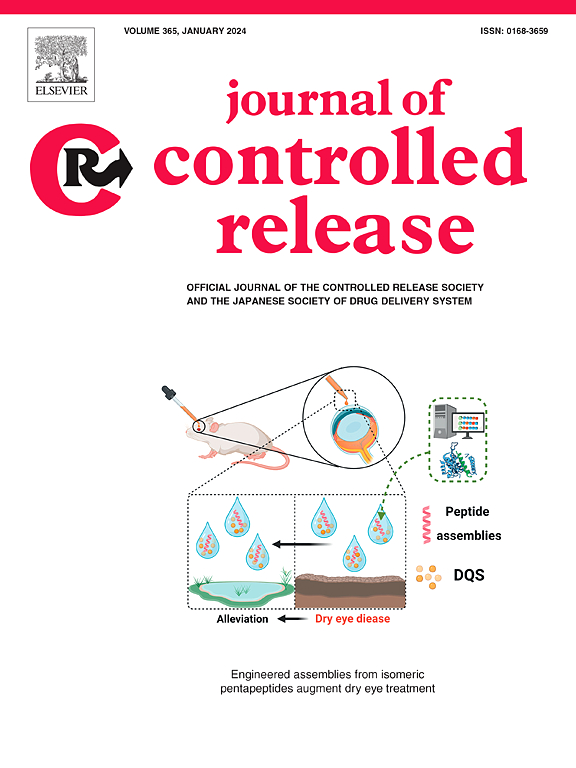用于评估抗癌药物疗效的片上通道组合肿瘤微环境。
IF 10.5
1区 医学
Q1 CHEMISTRY, MULTIDISCIPLINARY
引用次数: 0
摘要
芯片上器官是评估疾病药物反应的先进系统。它模拟体内肿瘤微环境,有助于了解药物机制和肿瘤反应。它模拟了肿瘤微环境的结构和体内的动态条件。因此,它具有应用于精准和个性化医疗的潜力。然而,顺序开发过程和复杂结构仍存在局限性,导致系统开发过程中分子干扰耗时。在本研究中,我们开发了一种通道组装型肿瘤微环境芯片(CATOC)系统,以克服这些限制。CATOC 易于分割为血管和肿瘤微环境芯片,可独立开发。片上肿瘤微环境由两个独立通道组成,用于评估不同类型肿瘤微环境中的药物反应。每个完全开发的系统都在物理上相互连接,以创建一个 CATOC。相互连接的 CATOC 用于验证不同亚型乳腺肿瘤微环境中的化学和靶向抗癌药物反应。我们还通过观察 CATOC 和无支架平台上肿瘤球体的药物反应,强调了芯片实验的重要性。本文章由计算机程序翻译,如有差异,请以英文原文为准。

Channel-assembling tumor microenvironment on-chip for evaluating anticancer drug efficacy
Organ-on-a-chip is an advanced system for evaluating drug response in diseases. It simulates the in vivo tumor microenvironment, aiding in the understanding of drug mechanisms and tumor responses. It mimics the structure of the tumor microenvironment and the dynamic conditions within the body. As a result, it holds the potential for applications in precision and personalized medicine. However, there are still limitations in sequential development processes and complex structures, resulting in time-consuming molecular interference during system development. In this study, we developed a channel-assembling tumor microenvironment-on-chip (CATOC) system to overcome these limitations. CATOC was easily segmented into blood vessels and a tumor microenvironment-on-chip, which can be independently developed. The tumor microenvironment-on-chip consists of two independent channels for evaluating drug responses in different types of tumor microenvironments. Each fully developed system was physically interconnected to create a CATOC. Interconnected CATOC was used to validate chemical and targeted anticancer drug responses in different subtypes of the breast tumor microenvironment. We also emphasized the significance of on-chip experiments by observing the drug response of tumor spheroids on CATOC and scaffold-free platforms.
求助全文
通过发布文献求助,成功后即可免费获取论文全文。
去求助
来源期刊

Journal of Controlled Release
医学-化学综合
CiteScore
18.50
自引率
5.60%
发文量
700
审稿时长
39 days
期刊介绍:
The Journal of Controlled Release (JCR) proudly serves as the Official Journal of the Controlled Release Society and the Japan Society of Drug Delivery System.
Dedicated to the broad field of delivery science and technology, JCR publishes high-quality research articles covering drug delivery systems and all facets of formulations. This includes the physicochemical and biological properties of drugs, design and characterization of dosage forms, release mechanisms, in vivo testing, and formulation research and development across pharmaceutical, diagnostic, agricultural, environmental, cosmetic, and food industries.
Priority is given to manuscripts that contribute to the fundamental understanding of principles or demonstrate the advantages of novel technologies in terms of safety and efficacy over current clinical standards. JCR strives to be a leading platform for advancements in delivery science and technology.
 求助内容:
求助内容: 应助结果提醒方式:
应助结果提醒方式:


